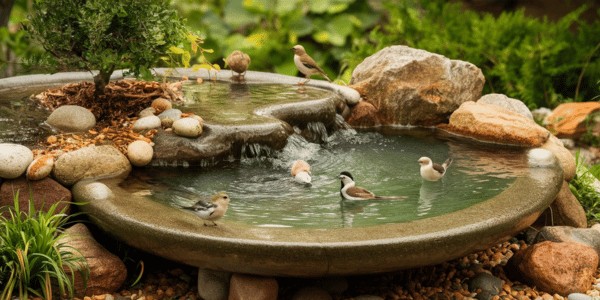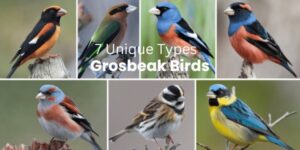Why Install a Bird Bath?
Bird baths are more than just garden ornaments; they are invitations for local
wildlife to visit your backyard. They not only provide birds with crucial drinking and bathing water but also create serene and beautiful surroundings for you. Think of waking up in the morning to the chirping of birds as they flutter around in water—pure bliss!
Choosing the Right Location
Sun or Shade?
The initial decision you’ll have to make is where to place it. Birds like mixed exposure: sun plus shade. Where the sunlight reaches for part of the day, but some areas offer a little bit of cooling off from heat, which would be perfect. It helps in maintaining cool water temperature and prevents it from getting too hot.
Safe Distance from Predators
Safety is key! A location away from obstacles is ideal so that birds can see predators coming their way, such as cats. Nonetheless, ensure that at least some trees or bushes are within proximity so that birds have somewhere fast to fly should danger arise. This balance ensures your feathered friends feel secure while enjoying their bath.
You May Also Like: What Color Attracts Birds To a Bird Bath?
Selecting the Perfect Bird Bath
Material Matters
Different materials are used for bird baths, each with its pros and cons. Concrete is strong, although it can be heavy and difficult to clean. Metal bird baths look good on your lawn; however, they may become very hot under direct sun rays. Ceramic and glass options tend to be beautiful but fragile at times, depending on how you treat them. Consider your local weather patterns and what kind of maintenance practices suit you best when selecting a material.
Size and Depth
Birdbath dimensions and depths matter greatly when choosing one for your home grounds. In case small birds predominate, then a shallow basin about 1-2 inches deep will do fine, while larger species need deeper ones, though those mustn’t be too deep since this could put other smaller species off using them. A wide basin that slopes down on all sides allows birds to enter the water at their own pace.
You May Also Like: How to Use Apple Cider Vinegar to Clean Your Bird Bath
Water Quality and Maintenance
Keeping the Water Clean
It is essential to maintain a bird bath regularly. Changing the water every few days keeps it from becoming stagnant and spreading disease. The basin should be scrubbed with a brush to get rid of dirt and algae growth. Freshwater attracts more species and ensures good health for them.
Preventing Algae Growth
Algae can be an ongoing problem in areas with plenty of sunshine. A little fountain or a water wiggler can help keep the water moving, thereby discouraging the growth of algae. Alternatively, vinegar and other eco-friendly ingredients can be used to keep this area clean and free from developing an algal layer over time.
You May Also Like: Where Can I Buy A Birdbath Near Me?

Attracting Birds to Your Bird Bath
Adding Movement to the Water
Moving water looks great! Consider adding small fountains, drippers, or misters to your bath. From afar off, gentle splashes plus glistening drops would easily catch any bird’s eye, making your bird bath popular with most of them.
Planting Bird-Friendly Flora
Encircle it with native plants that serve as a source of food and shelter only if they are plants for birds, actually, because other types may not work quite effectively. Flowering plants bring insects, which become meals for insectivorous birds later. Shrub-producing fruits provide nutrition, while thick foliage becomes hiding spots for these creatures, thus promoting nesting grounds.
You May Also Like: Top 10 Gifts for Someone Who Likes Birdwatching
Seasonal Considerations
Winterizing Your Bird Bath
Even though the weather is getting colder, you can still help out your local birds. In winter, the bird bath should be kept from freezing either by using a heater or floating something on top of the water. Additionally, you may need to change the water regularly to prevent it from turning into ice.
Summer Care Tips
Water evaporates quickly during hot summer days. Check your bird bath every day and ensure that it contains enough water in it. Adding ice cubes will enable the birds to enjoy cool and refreshing water. Wash your basin frequently so as not to spread bacteria.
Common Mistakes to Avoid
One mistake is putting a bird bath too close to feeders, which may cause droppings to contaminate the water. Another is not changing the water often, which leads to motionless water attracting mosquitoes. Lastly, avoid using chemicals or detergents to clean the bird bath; such substances harm birds.
Enhancing Your Bird Bath Experience
Adding Decorative Elements
Personalize your birdbath with decorative pebbles, stones, or statues. These add extra perching places for birds and make your birdbath an eye-catching feature in your garden. Just ensure that any additions are safe for the birds and do not create obstacles.
Creating a Bird-Friendly Environment
Look beyond just a bird bath and turn your entire garden into a sanctuary for birds. Diversify by providing them with various kinds of seeds in feeders, installing nesting boxes, and avoiding pesticides. This will attract more species and allow them to stay longer at such an environmentally friendly home.
Final Thoughts
The installation of a birdbath is satisfying, given that it adds beauty and vitality to one’s garden area. With these eight points in mind, you can ensure that there is an inviting oasis for your feathered friends that is also secure and visually appealing for human beings like yourself. Not only will you love watching birds, but you will also be promoting their well-being. Happy birdwatching!
FAQs
How often should I change the water in my bird bath?
Change the water every 2-3 days to maintain its freshness and cleanliness.
Can I use tap water in my bird bath?
Tap water is generally safe, but if your tap water is highly chlorinated, it’s better to wait for 24 hours before adding it to the birdbath.
How do I prevent mosquitoes in my bird bath?
The easiest way to prevent mosquito breeding is to regularly change the water and add a fountain or a wiggler.
What should I do if algae keeps growing in my bird bath?
The basin should be cleaned with vinegar and water, with some kind of movement, such as a small fountain, added to the top of the water.
Is it okay to use a bird bath in winter?
In winter, when there is excessive cold, a heater or regular water replacement can prevent it from freezing completely, enabling its use.












One Response